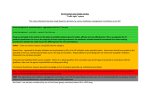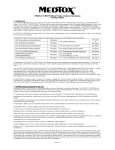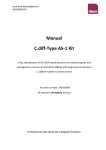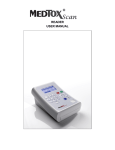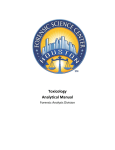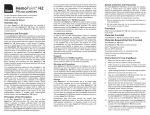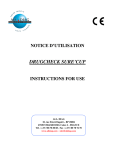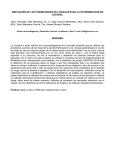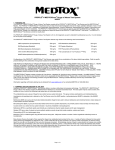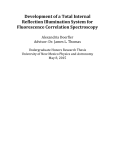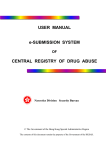Download Triage® TOX Drug Screen Product Insert
Transcript
Triage TOX Drug Screen Product Insert ® Rapid Qualitative simultaneous detection of drug and/or the major urinary metabolites of 10 different drug classes (11 unique assays). Triage TOX Drug Screen ® Product Insert Product Insert Catalog#: 94400 Intended Use The Alere Triage® TOX Drug Screen is a fluorescence immunoassay to be used with the Alere Triage® Meters for the qualitative determination of the presence of drug and/or the major metabolites above the threshold concentrations of up to 10 distinct drug classes, including assays for acetaminophen/paracetamol, amphetamines, methamphetamines, barbiturates, benzodiazepines, cocaine, methadone, opiates, phencyclidine, THC and tricyclic antidepressants in urine. The acetaminophen/paracetamol assay will yield positive results when acetaminophen/paracetamol is ingested at or above therapeutic doses. The threshold concentrations are provided below: Acetaminophen/Paracetamol APAP 5 µg/mL Amphetamines AMP 1000 ng/mL Methamphetamines mAMP 1000 ng/mL Barbiturates BAR 300 ng/mL Benzodiazepines BZO 300 ng/mL Cocaine COC 300 ng/mL Methadone MTD 300 ng/mL Opiates OPI 300 ng/mL Phencyclidine PCP 25 ng/mL THC THC 50 ng/mL Tricyclic Antidepressants TCA 1000 ng/mL This test provides only a preliminary result. Clinical consideration and professional judgment must be applied to any drug of abuse test result, particularly in evaluating a preliminary positive result. In order to obtain a confirmed analytical result, a more specific alternate chemical method is needed. Gas Chromatography/Mass Spectrometry (GC/MS), Liquid Chromatography/ Mass Spectrometry/ Mass Spectrometry (LC/MS/MS) and High Performance Liquid Chromatography (HPLC) are common confirmatory methods. A quantitative serum acetaminophen/paracetamol measurement is the common confirmatory method for preliminary positive acetaminophen/paracetamol results. © 2011 Alere. All rights reserved. 1 Summary and Explanation of the Test Drug abuse in the United States continues to be an increasingly significant social and economic problem. Opiates, cocaine, THC, amphetamines and phencyclidine are recognized by the Substance Abuse and Mental Health Services Administration (SAMHSA) as the most frequently abused illicit drugs. Benzodiazepines, tricyclic antidepressants, barbiturates and opiate compounds are among a group of prescription drugs that also are frequently abused. Acetaminophen/paracetamol overdose is a significant concern due to the risk of hepatotoxicity. The opiate class of compounds that may produce a positive result include illicit opiates as well as cough medications containing codeine. Methadone, although known for its use in the maintenance treatment of heroin addicts, has abusive potential because it produces morphine-like drug dependence. Urine-specific screening tests for drugs of abuse range from simple immunoassay tests to complex analytical procedures. The speed and sensitivity of immunoassays have made them the most accepted method for screening urine for the presence of drugs. The Alere Triage® TOX Drug Screen uses distinct immunoassays for the simultaneous detection of drug and/or the major urinary metabolites of 10 different drug classes (11 unique assays). The use of monoclonal antibodies that are specific for the metabolites of the 10 drug classes ensures a high degree of sensitivity and specificity. Principles of the Procedure The Alere Triage® TOX Drug Screen is a competitive fluorescence immunoassay designed for the qualitative determination of parent drugs and/or drug metabolites in urine specimens. The test procedure involves the addition of a urine specimen to the sample port on the Test Device. After addition of the specimen, the urine passes through a filter. The specimen reacts with fluorescent antibody conjugates or with fluorescent drug conjugates and flows through the Test Device by capillary action. The presence of drug or drug metabolite in the urine specimen prevents binding of the fluorescent conjugates to the solid phase on the detection zone. Excess urine washes the unbound fluorescent conjugates from the detection lane into a waste reservoir. The Test Device is inserted into the Alere Triage® Meters (hereafter referred to as Meter). The Meter is programmed to perform the analysis after the specimen has reacted with the reagents within the Test Device. The analysis is based on the amount of fluorescence the Meter detects within a measurement zone on the Test Device. The positive or negative results are displayed on the Meter screen in approximately 15 minutes from the addition of specimen. All results are stored in the Meter memory to display or print when needed. If connected, the Meter can transmit results to the laboratory or hospital information system. 2 © 2011 Alere. All rights reserved. Reagents and Materials Provided The Test Device contains all the reagents necessary for the qualitative determination of drugs and/or their metabolites in human urine. The Test Device Contains: • Murine monoclonal antibodies against drug metabolites • Fluorescent dye • Stabilizers Alere Triage® TOX Drug Screen Catalog # 94400 Kit contains: 25 Test Devices 25 Transfer Pipettes 1 Reagent CODE CHIP™ Module 2 Printer Paper Rolls Materials Required but Not Provided Alere Triage® MeterPro Catalog # 55070 or 55071 or Triage® MeterPlus Catalog # 55040 or 55041 Alere Triage® TOX Drug Screen Control 1 Catalog # 94413 Alere Triage® TOX Drug Screen Control 2 Catalog # 94414 Warnings and Precautions • For In Vitro Diagnostic Use. • For use by healthcare professionals. • Do not use the kit beyond the expiration date printed on the outside of the box. • Carefully follow the instructions and procedures described in this insert. • Keep the Test Device in the sealed pouch until ready for immediate use. Discard after single use. • The transfer pipette should be used for one patient specimen only. Discard after single use. • Patient specimens, used Test Devices and used transfer pipettes are potentially infectious. Proper handling and disposal methods should be established by the laboratory in accordance with local, state and federal regulations. © 2011 Alere. All rights reserved. 3 Storage and Handling Requirements • Store the Test Devices in a refrigerator at 2-8°C (35-46°F). • Once removed from refrigeration, the pouched Test Device is stable for up to 14 days at room temperature, but not beyond the expiration date printed on the pouch. With a soft, felt tip marker, gently write the date and time of removal from the refrigerator on the pouch and cross out the manufacturer expiration date printed on the pouch. Care must be taken to document the time the product is at room temperature. Once equilibrated to room temperature, do not return the Test Device to refrigeration. • Before using refrigerated Test Devices, allow individual foil pouches to reach operating temperature (20-24°C or 68- 75°F). This will take a minimum of 15 minutes. If a kit containing multiple Test Devices is removed from refrigeration, allow the kit to reach room temperature before use. This will take a minimum of 60 minutes. • Do not remove the Test Device from the pouch until prepared for immediate use. Specimen Collection and Preparation Freshly voided urine specimens should be collected in a clean, previously unused glass or plastic container. If the specimen is not tested immediately it should be refrigerated at 2-8°C for a maximum of two days. If longer storage is required, specimens may be stored frozen at –20°C or colder. Test Procedure Lot Calibration Using the Reagent CODE CHIP™ Module When a new lot of Test Devices is opened, the calibration and expiration data for that lot of Test Devices must be transferred to the Meter before patient testing. Use the Reagent CODE CHIPTM module supplied with the new lot of Test Devices to transfer the data to the Meter. Reagent CODE CHIP™ Module Perform one time for each new lot of Test Devices 1. From the main screen, select Install New Code Chip. Press Enter. 2. Place the Reagent CODE CHIP™ module into the lower left front corner of the Meter and follow the prompts on the screen. 4 © 2011 Alere. All rights reserved. 3. Remove the Reagent CODE CHIP™ module from the Meter when data transfer is complete. 4. Place the Reagent CODE CHIP™ module back into its original container for storage. Testing Patient Specimens Procedural Notes • For each day of patient testing, perform QC Device testing. Refer to the Quality Control Considerations section. • Frozen and refrigerated specimens must be allowed to reach room temperature and be mixed thoroughly prior to testing. • Specimens containing a large amount of particulate matter may be clarified by centrifuging or allowed to settle prior to testing. STEP 1- Add Patient Specimen 1. Open the pouch and label the Test Device with the patient identification number. 2. Place the Test Device on a level, horizontal surface. 3. Using the transfer pipette, squeeze the larger (top) bulb completely and insert the tip into the patient specimen. 4. Release the bulb slowly. The transfer pipette barrel should fill completely with some fluid flowing into the smaller (lower) bulb. 5. Place the tip of the transfer pipette into the sample port of the Test Device and squeeze the larger bulb completely. The entire volume of fluid in the transfer pipette barrel must flow into the sample port. The specimen in the smaller (lower) bulb will not be expelled. 6. Remove the transfer pipette tip from the sample port and then release the larger (top) bulb. 7. Discard the transfer pipette. 8. Allow specimen to absorb completely before moving the Test Device. STEP 2- Run Test 1. From the main screen, select Run Test and press Enter. 2. Select Patient Sample and press Enter. 3. Enter the patient identification number and press Enter. 4. Confirm that the number was entered correctly by selecting Confirm Patient ID and pressing Enter. If the number was not entered correctly, select Correct Patient ID, press Enter and repeat the previous step. 5. Holding the Test Device by the edges, insert the Test Device into the Meter and press Enter. The results will be displayed when the analysis is complete. Note: The Test Device must be inserted into the Meter within 30 minutes from the time the patient specimen was added. A delay longer than 30 minutes may cause the results to be invalid and blocked out on the printout. © 2011 Alere. All rights reserved. 5 STEP 3- Read The Results 1. Results may be printed by pressing the Print button. 2. Discard the Test Device after release from the Meter. 3. A blocked out result indicates the result was invalid and the test should be repeated. Results The following threshold concentrations are established for the drug assays: Acetaminophen/Paracetamol APAP 5 µg/mL Amphetamines AMP 1000 ng/mL Methamphetamines mAMP 1000 ng/mL Barbiturates BAR 300 ng/mL Benzodiazepines BZO 300 ng/mL Cocaine COC 300 ng/mL Methadone MTD 300 ng/mL Opiates OPI 300 ng/mL Phencyclidine PCP 25 ng/mL THC THC 50 ng/mL Tricyclic Antidepressants TCA 1000 ng/mL These threshold concentrations are used to separate a negative result from a presumptive positive result. Results are displayed in the following manner: Example PAT. ID 123 APAP AMP mAMP BAR BZO COC MTD POS NEG NEG NEG NEG POS POS OPI PCP THC TCA POS NEG NEG NEG PAT. RESULT ABNORMAL PRESS PRINT OR PRESS EXIT The Meter displays the results as either “POS” if the result is at or above the threshold or “NEG” if the result is below the threshold. The operator has the option to print the results. 6 © 2011 Alere. All rights reserved. For additional information refer to the Alere Triage® Meter User Manual. The APAP assay is designed to yield positive results following ingestion of acetaminophen/ paracetamol at or above therapeutic doses. Urine specimens from 15 healthy individuals who were not currently taking acetaminophen/paracetamol all yielded negative APAP results using the Alere Triage® TOX Drug Screen. Multiple urine specimens were collected from the same individuals following ingestion of 1,000 mg acetaminophen/paracetamol 30 minutes after ingestion and over the course of 2.5 to 9 hours. All urine specimens collected post-ingestion yielded positive APAP results using the Alere Triage® TOX Drug Screen. A specimen may contain drug and/or drug metabolites at concentrations that do not exceed the threshold concentrations that would otherwise classify the test result as positive. In order to obtain a confirmed analytical result, a more specific alternate chemical method is needed. Gas Chromatography/Mass Spectroscopy (GC/MS) is the preferred confirmatory method. A quantitative serum acetaminophen/paracetamol measurement is the common confirmatory method for preliminary positive acetaminophen/paracetamol results. Refer to the Performance Characteristics section for additional information. Quality Control Considerations Every Alere Triage® TOX DS Test Device is a qualitative test device that includes negative and positive controls that are run automatically with every patient specimen, external liquid control solution, or proficiency testing sample. If the automatic check of these built-in controls shows that the control value results are within the limits set during manufacturing, the Meter will report a result for the specimen or sample being tested. If the automatic check of these built-in controls shows that the control value results are not within the limits set during manufacturing, a test result will not be reported. Instead, the Meter will display a warning or error message that is described in the Alere Triage® Meter User Manual. Good Laboratory Practice suggests that external controls should be tested with each new lot or shipment of test materials, or every 30 days, and as otherwise required by your laboratory’s standard quality control procedures. Controls should be tested in the same manner as if testing patient specimens. When running patient specimens or external controls, if an analyte fails for any reason (built-in control failure or an external control out of range) no patient results will be reported. Users should follow government guidelines (for example, federal, state or local) and/or accreditation requirements for quality control. Performing Alere Triage® System Quality Control – QC Device Use the QC Device to ensure proper function of the Meter. Perform QC Device testing for the following conditions: • Upon initial setup of the Meter. • Each day of patient testing. • When the Meter has been transported or moved. • Whenever there is uncertainty about the performance of the Meter. • Whenever required by your laboratory’s quality control requirements. Do not discard the Alere Triage® QC Device and associated CODE CHIP™ module. Store them in the QC Device Box. © 2011 Alere. All rights reserved. 7 Refer to the Alere Triage® Meter User Manual for complete instructions for use of the QC Device. 1. The first time a new QC Device is run in the Meter, install the QC Device CODE CHIP™ module. The QC Device CODE CHIP™ module data is stored in the Meter memory. The QC Device CODE CHIP™ module does not need to be reinstalled after the first time. QC Device CODE CHIP™ Module a. From the main screen, select Install New Code Chip and press Enter. b. Place the QC Device CODE CHIP™ module into the lower left front corner of the Meter. Follow the prompts on the screen. c. Remove the QC Device CODE CHIP™ module from the Meter when data transfer is complete. d. Place the QC Device CODE CHIP™ module back into the QC Device Box for storage. 2. From the main screen, select Run Test and press Enter. 3. If User ID is enabled enter your User ID number and press Enter. 4. Select QC Device and press Enter. 5. Insert QC Device into the Meter and press Enter. 6. A Pass or Fail result will be displayed when complete. Each parameter should pass before patient testing is performed. 7. Remove the QC Device from the Meter and place in the QC Device Box. DO NOT DISCARD THE QC DEVICE. Note: If the QC Device or external controls do not perform as expected, review the above instructions to see if the test was performed correctly, repeat the test, then contact Alere or your local Alere representative (refer to Contact Alere section). Refer to the Alere Triage® Meter User Manual for a complete description of the quality control system. 8 © 2011 Alere. All rights reserved. Limitations of the Procedure • Adulterants, such as bleach or other strong oxidizing agents, added to urine specimens may produce erroneous results regardless of the method of analysis. If adulteration is suspected, obtain an additional specimen and re-test using a new Test Device. • A presumptive positive result does not indicate the level of intoxication, nor does it indicate the route of administration. • There is a possibility that substances and/or factors may interfere with the test and cause false results. Technical or procedural errors can also contribute to erroneous results. • There are no uniformly recognized threshold concentrations for urine-based acetaminophen/ paracetamol assays. The test indicates that the analyte was or was not present above the threshold concentration. • Test results must always be evaluated with other data available to the physician. • The performance of this product has been established for human urine only. Other specimen types have not been evaluated. Performance Characteristics Threshold Validation Specimens used for threshold validation contained each drug or drug metabolite spiked into drug-free urine at concentrations in increments of 25% above and below the threshold. Each specimen was tested using the Alere Triage® TOX Drug Screen. The data paralleled the expected agreement based on the Coefficient of Variation of the assays. It is important to use sound clinical judgment with any result, particularly those near the threshold concentration. If an aberrant result is suspected, the sample should be re-tested using the Alere Triage® TOX Drug Screen or a reference method such as GC/MS. 50% Below Threshold APAP Concentration Positive/Negative Accuracy AMP 2.5 500 0/10 0/10 100% 100% mAMP BAR BZO COC MTD OPI PCP THC TCA 500 0/10 100% 150 0/10 100% 150 0/10 100% 150 0/10 100% 150 0/10 100% 150 0/10 100% 12.5 0/10 100% 25 0/10 100% 500 0/10 100% 25% Below Threshold Concentration Positive/Negative Accuracy APAP AMP mAMP BAR BZO COC MTD OPI PCP THC TCA 3.75 4/26 87% 750 0/30 100% 750 0/30 100% 225 1/29 97% 225 0/30 100% 225 1/29 97% 225 0/30 100% 225 0/30 100% 18.75 1/29 97% 37.5 0/30 100% 750 0/30 100% APAP AMP mAMP BAR BZO COC MTD OPI PCP THC TCA 6.25 28/2 93% 1250 30/0 100% 1250 29/1 97% 375 28/2 93% 375 30/0 100% 375 29/1 97% 375 28/2 93% 375 25/5 83% 31.25 27/3 90% 62.5 30/0 100% 1250 28/2 93% 25% Above Threshold Concentration Positive/Negative Accuracy © 2011 Alere. All rights reserved. 9 50% Above Threshold APAP Concentration Positive/Negative Accuracy AMP 7.5 1500 10/0 10/0 100% 100% mAMP BAR BZO COC MTD OPI PCP THC TCA 1500 10/0 100% 450 10/0 100% 450 10/0 100% 450 10/0 100% 450 10/0 100% 450 10/0 100% 37.5 10/0 100% 75 10/0 100% 1500 10/0 100% Specificity The specificity of each of the 11 assays in the Alere Triage® TOX Drug Screen has been tested with over 100 drugs and closely related compounds. Representative data are listed below, expressed as the concentration that produced a positive result during development studies. The individual assays are calibrated against the compounds marked with an asterisk (*). 10 Acetaminophen/Paracetamol Acetaminophen* µg/mL 5 Amphetamines d-Amphetamine* l-Amphetamine MDA Chloroamphetamine, 4- ng/mL 1,000 63,500 3,700 2,300 Methamphetamines Ethylamphetamine Isometheptine MDEA MDMA d-Methamphetamine* l-Methamphetamine Propylamphetamine ng/mL 12,500 100,000 4,600 1,500 1,000 30,500 >200,000 Barbiturates Allobarbital Amobarbital Aprobarbital Barbital Butabarbital Butalbital Butethal Cyclopentobarbital Hexobarbital Hydroxyphenobarbital, p- Mephobarbital Metharbital Phenallymal Pentobarbital* Phenobarbital Secobarbital Talbutal Thiopental ng/mL 150 100 200 150 200 150 50 100 >100,000 350 20,000 1,400 100 300 150 300 200 >100,000 © 2011 Alere. All rights reserved. Benzodiazepines Alprazolam Alprazolam, -OH Alprazolam glucuronide, -OH Bromazepam Chlordiazepoxide Clonazepam Clorazepate Demoxepam Desalkylflurazepam Diazepam Estazolam* Flunitrazepam Flurazepam Halazepam Lorazepam Lorazepam glucuronide Medazepam Nitrazepam Norchlordiazepoxide Nordiazepam Oxazepam Oxazepam glucuronide Prazepam Temazepam Temazepam glucuronide Triazolam Cocaine Benzoylecgonine* Cocaethylene Ecgonine Ecgonine methyl ester Propylbenzoylecgonine ng/mL 100 100 150 750 13,000 650 1,600 7,700 200 200 300 150 100 100 200 300 32,000 2,600 24,500 700 3,500 1,100 1,400 200 1,000 50 ng/mL 300 165,000 133,000 >200,000 >200,000 Methadone l-methadone d-methadone d/l-methadone* ng/mL 175 14,000 300 Opiates Acetylcodeine, 6- Acetylmorphine, 6- Codeine Diacetylmorphine Dihydrocodeine Ethylmorphine Hydrocodone ng/mL 250 300 300 300 250 300 1,700 © 2011 Alere. All rights reserved. 11 Hydromorphone Morphine* Morphine 3- glucuronide Nalorphine Norcodeine Normorphine Oxycodone Oxymorphone Thebaine PCP PCP* 1,700 300 450 1,900 23,000 >150,000 23,000 41,000 24,000 ng/mL 25 THC ng/mL 11-nor-9 carboxy-∆9-THC* 50 11-nor-9 carboxy-∆9-THC-glucuronide 50 8 Cannabinol, ∆ - >2,000 9 Cannabinol, ∆ - >2,000 Tricyclic Antidepressants Amitriptyline Amitryptyline metabolite Chlorpromazine† Chlorprothixene† Clomipramine Cyclobenzaprine† Desipramine* Doxepin Imipramine Maprotiline† Nordoxepin Nortriptyline Perphenazine† Phenothiazine† Promazine† Protriptyline Thiothixene† Trimeprazine† Trimipramine † 12 Structurally related compounds © 2011 Alere. All rights reserved. ng/mL 750 250 >400,000 84,000 12,500 1,900 1000 1,300 600 176,000 1,500 1,100 >300,000 >300,000 77,000 3,300 46,000 83,500 3,000 Pharmaceuticals The following compounds were found not to cross-react when tested at concentrations up to at least 100 µg/ml (unless otherwise indicated in parentheses.)1 Acetopromazine Benzphetamine Benztropine Methane Bupropion Butyrophenone Cimetidine Clonidine Cotinine Dextromethorphan Dextrorphan Diphenhydramine Dopamine Doxylamine Succinate (60) Epinephrine, lFenfluramine (20) Glutethimide Ketorolac Tromethamine Levorphanol (50) Meperidine Mesoridazine Methaqualone Methoxyphenamine Methylphenidate Naloxone (80) Naproxen Norpsuedoephedrine Phenethylamine Phenmetrazine Phentermine Phenylephrine Phenylhydantoin, d/l-5-(p-hydroxyphenyl)-5Phenylpropanolamine Promethazine Propanolol, d/l Propoxyphene Pseudoephedrine, dQuinacrine Ranitidine Thioridazine Tramadol Tyramine (60) Tranylcypromine Zolpidem © 2011 Alere. All rights reserved. 13 Interference Potential interfering substances were evaluated by adding the substance to human urine spiked with drug 25% above and 25% below the threshold concentration. Each specimen was evaluated on the Alere Triage® TOX Drug Screen. The following substances did not produce false positive or false negative results when tested at the following concentrations: Substance Concentration Acetaminophen* 1 mg/mL Acetone 5 mg/mL Acetylsalicylic Acid Ascorbic Acid 1 mg/mL 15 mg/mL Bilirubin 2.5 µg/mL Caffeine 0.125 mg/mL Creatinine 2.5 mg/mL Dextrose 20 mg/mL Ethanol Fluoxetine Gamma Globulin Hemoglobin Human Serum Albumin 5 mg/mL 0.5 mg/mL 5 mg/mL 1.2 mg/mL 5 mg/mL Ibuprofen 1 mg/mL Ketamine 25 µg/mL Oxalic Acid Riboflavin Scopalamine 2.5 mg/mL 75 µg/mL 62.5 µg/mL Sodium Chloride 30 mg/mL Urea 30 mg/mL * Refer to the Specificity section for the Acetaminophen/Paracetamol assay. In addition, the effects of pH and specific gravity were determined by testing specimens with having a range of pH values and specimens having a range of specific gravity values. Each specimen was tested using the Alere Triage® TOX Drug Screen and the measured concentrations were plotted as a function of either pH or specific gravity. There was no significant effect of pH and specific gravity on the misclassification of results observed within the normal ranges (pH 4.5-8.0; specific gravity 1.002-1.030). 14 © 2011 Alere. All rights reserved. Accuracy The performance of the Alere Triage® TOX Drug Screen was evaluated using clinical urine specimens and compared to the reference methods. GC/MS was the reference method used for all assays with the exception of TCA, for which HPLC was the reference method used. Positive specimens that were previously evaluated for the presence of each of the specific drugs using reference methods were re-evaluated using the Alere Triage® TOX Drug Screen. Comparisons between the reference values and the Alere Triage® TOX Drug Screen were made using the thresholds described earlier. The results are presented below. APAP Near Threshold Near Threshold Negative Negative Positive Positive (<25% below threshold) (within 25% below threshold) (within 25% above threshold) (>25% above threshold) Positive 0 3 12 27 Negative 55 5 0 0 Alere Triage® TOX % Agreement = 97.1% Note: The Alere Triage® TOX Drug Screen positive, GC/MS negative contain APAP determined by GC/MS to be within approximately 10% of the threshold concentration. AMP Alere Triage® TOX Near Threshold Near Threshold Negative Negative Positive Positive (<25% below threshold) (within 25% below threshold) (within 25% above threshold) (>25% above threshold) Positive 0 1 2 36 Negative 53 8 2 0 % Agreement = 97.1% Note: The Alere Triage® TOX Drug Screen positive, GC/MS negative and all of the Alere Triage® TOX Drug Screen negative, GC/MS positive specimens contain AMP determined by GC/MS to be within approximately 10% of the threshold concentration. © 2011 Alere. All rights reserved. 15 mAMP Alere Triage® TOX Near Threshold Near Threshold Negative Negative Positive Positive (<25% below threshold) (within 25% below threshold) (within 25% above threshold) (>25% above threshold) Positive 1 1 5 34 Negative 51 9 1 0 % Agreement = 97.1% Note: One of the Alere Triage® TOX Drug Screen positive, GC/MS negative and the Alere Triage® TOX Drug Screen negative, GC/MS positive specimens contain mAMP at concentrations determined by GC/MS to be within approximately 10% of the threshold concentration. The additional Alere Triage® TOX Drug Screen positive, GC/MS negative specimen contained a significant amount of mAMP as determined by GC/MS and yielded a result on the Alere Triage® TOX Drug Screen that was only 1% above the threshold concentration. BAR Near Threshold Near Threshold Negative Negative Positive Positive (<25% below threshold) (within 25% below threshold) (within 25% above threshold) (>25% above threshold) Positive 3 5 5 33 Negative 35 0 0 0 Alere Triage® TOX % Agreement = 90.1% Note: Discrepant samples were evaluated by comparing the Alere Triage® TOX Drug Screen BAR values with GC/MS values and the metabolites present. Seven of the eight specimens that were classified as negative by GC/MS but positive by the Alere Triage® TOX Drug Screen contained either butalbital or phenobarbital at concentrations determined by GC/MS to be above those required to yield a positive result on the Alere Triage® TOX Drug Screen (see the section on Specificity above). The additional GC/MS negative, Alere Triage® TOX Drug Screen positive sample contained butalbital at a concentration that was determined by GC/MS to be within about 6% of that required to yield a positive on the Alere Triage® TOX Drug Screen. 16 © 2011 Alere. All rights reserved. BZO Near Threshold Near Threshold Negative Negative Positive Positive (<25% below threshold) (within 25% below threshold) (within 25% above threshold) (>25% above threshold) Positive 0 1 5 41 Negative 35 1 1 0 Alere Triage® TOX % Agreement = 97.6% Note: Discrepant samples were evaluated by comparing the Alere Triage® TOX Drug Screen BZO values with GC/MS values and the metabolites present. The specimen that was positive by GC/MS but negative by the Alere Triage® TOX Drug Screen contained oxazepam at a concentration determined to be below that required to yield a positive on the Alere Triage® TOX Drug Screen (see the section on Specificity above). The specimen that was negative by GC/MS but positive by the Alere Triage® TOX Drug Screen contained a BZO at a concentration determined by GC/MS to be within 20% of the threshold concentration. COC Alere Triage® TOX Near Threshold Near Threshold Negative Negative Positive Positive (<25% below threshold) (within 25% below threshold) (within 25% above threshold) (>25% above threshold) Positive 0 0 2 32 Negative 39 7 3 0 % Agreement = 96.4% Note: All of the Alere Triage® TOX Drug Screen negative, GC/MS positive specimens contain COC determined by GC/MS to be within 15% of the threshold concentration. © 2011 Alere. All rights reserved. 17 MTD Alere Triage® TOX Near Threshold Near Threshold Negative Negative Positive Positive (<25% below threshold) (within 25% below threshold) (within 25% above threshold) (>25% above threshold) Positive 4 5 5 40 Negative 46 2 0 0 % Agreement = 94.1% Note: All of the Alere Triage® TOX Drug Screen positive, GC/MS negative samples contained measurable amounts of methadone (>100 ng/ml), and 8 of the 9 samples contained concentrations greater than the threshold value established for l-methadone of 175 ng/ml. Since GC/MS is unable to distinguish between the two enantiomeric forms, if the methadone form present in these patient samples is l-methadone, the percent agreement between the two methods would be 99%. OPI Near Threshold Near Threshold Negative Negative Positive Positive (<25% below threshold) (within 25% below threshold) (within 25% above threshold) (>25% above threshold) Positive 0 4 8 37 Negative 36 3 0 0 Alere Triage® TOX % Agreement = 95.5% Note: All of the specimens that tested negative by GC/MS but positive by the Alere Triage® TOX Drug Screen contained OPI at concentrations determined by GC/MS to be within 20% of the threshold concentration. 18 © 2011 Alere. All rights reserved. PCP Near Threshold Near Threshold Negative Negative Positive Positive (<25% below threshold) (within 25% below threshold) (within 25% above threshold) (>25% above threshold) Positive 0 1 5 30 Negative 36 5 2 2 Alere Triage® TOX % Agreement = 93.8% Note: The specimen that was positive by the Alere Triage® TOX Drug Screen and negative by GC/MS, as well as two of the specimens that were negative by the Alere Triage® TOX Drug Screen and positive by GC/MS contained PCP at concentrations determined by GC/MS to be within 25% of the threshold concentration. THC Near Threshold Near Threshold Negative Negative Positive Positive (<25% below threshold) (within 25% below threshold) (within 25% above threshold) (>25% above threshold) Positive 0 7 6 30 Negative 37 1 0 0 Alere Triage® TOX % Agreement = 91.4% Note: Discrepant samples were evaluated by comparing the Alere Triage® TOX Drug Screen THC values with GC/MS values. The Mandatory Guidelines for Federal Workplace Drug Testing Programs published by SAMHSA in 1994 indicate that samples containing marijuana metabolite >15ng/ml are considered positive by GC/MS. Applying this criterion to the GC/MS results resolved all results classified as negative by GC/MS and positive by the Alere Triage® TOX Drug Screen in the above contingency table but produced one specimen classified as positive by GC/MS and negative by the Alere Triage® TOX Drug Screen, yielding a percent agreement of 98.8%. © 2011 Alere. All rights reserved. 19 TCA Alere Triage® TOX Near Threshold Near Threshold Negative Negative Positive Positive (<25% below threshold) (within 25% below threshold) (within 25% above threshold) (>25% above threshold) Positive 0 4 8 27 Negative 35 2 3 0 % Agreement = 91.1% Note: All of the specimens that were positive by the Alere Triage® TOX Drug Screen and negative by the reference method, as well as all of the specimens that were negative by the Alere Triage® TOX Drug Screen and positive by the reference method contained TCA at concentrations determined by the reference method to be within 25% of the threshold concentration. 20 © 2011 Alere. All rights reserved. Bibliography of Suggested Reading Data on file at Alere San Diego, Incorporated. Baselt, R.C., In: Disposition of Toxic Drugs and Chemicals in Man. Davis, CA. Biomedical Communication, 1980. Urine Testing for Drugs of Abuse, NIDA Research Monograph 73, 1986. Federal Register, Department of Health and Human Services, Mandatory Guidelines for Federal Workplace Testing Programs. 59, 110, 29908-29931, 1994; 53, 69, 11970-11979, 1988. The Pharmacological Basis of Therapeutics, A.G. Gilman, L.S. Goodman, and A. Gilman eds. MacMillan Publishing, New York, NY, 1980. © 2011 Alere. All rights reserved. 21 Glossary of Symbols Do not reuse Use by Batch code Catalog number Consult instructions for use Manufacturer 2 ºC 22 8ºC Authorized representative in the European Community In Vitro diagnostic medical device Store at 2 - 8°C Test Device Contents Transfer pipette Patient number Printer paper CODE CHIP TM module Add sample immediately after opening foil pouch. Use urine sample only. Add sample here Peel open here CE Mark © 2011 Alere. All rights reserved. Contact Alere Alere™ Product Support Contact one of the following Alere™ Product Support Care Centers or your local distributor if you have any questions regarding the use of your Alere™ product. You may also contact us at www.alere.com. Region Phone E Mail Address Europe & Middle East + 44.161.483.9032 [email protected] Asia Pacific + 61.7.3363.7711 [email protected] Africa, Russia, & CIS + 972.8.9429.683 [email protected] Latin America + 57.01800.094.9393 [email protected] Canada + 1.613.271.1144 [email protected] US + 1.877.308.8287 [email protected] Alere™ Customer Service Contact the following Alere™ Service Care Center or your local distributor for order and billing assistance. You may also contact us at www.alere.com. Phone + 1.877.441.7440 E Mail Address [email protected] © 2011 Alere. All rights reserved. 23 Limited Warranty. FOR THE APPLICABLE WARRANTY PERIOD, ALERE WARRANTS THAT EACH PRODUCT SHALL BE (I) OF GOOD QUALITY AND FREE OF MATERIAL DEFECTS, (II) FUNCTION IN ACCORDANCE WITH THE MATERIAL SPECIFICATIONS REFERENCED IN THE PRODUCT MANUAL, AND (III) APPROVED BY THE PROPER GOVERNMENTAL AGENCIES REQUIRED FOR THE SALE OF PRODUCTS FOR THEIR INTENDED USE (the “LIMITED WARRANTY”). IF THE PRODUCT FAILS TO MEET THE REQUIREMENTS OF THE LIMITED WARRANTY, THEN AS CUSTOMER’S SOLE REMEDY, ALERE SHALL EITHER REPAIR OR REPLACE, AT ALERE’S DISCRETION, THE PRODUCT. EXCEPT FOR THE LIMITED WARRANTY STATED IN THIS SECTION, ALERE DISCLAIMS ANY AND ALL WARRANTIES, EXPRESS OR IMPLIED, INCLUDING BUT NOT LIMITED TO, ANY WARRANTY OF MERCHANTABILITY, FITNESS FOR A PARTICULAR PURPOSE AND NON-INFRINGEMENT REGARDING THE PRODUCT. ALERE’S MAXIMUM LIABILITY WITH ANY CUSTOMER CLAIM SHALL NOT EXCEED THE NET PRODUCT PRICE PAID BY CUSTOMER. NEITHER PARTY SHALL BE LIABLE TO THE OTHER PARTY FOR SPECIAL, INCIDENTAL OR CONSEQUENTIAL DAMAGES, INCLUDING, WITHOUT LIMITATION, LOSS OF BUSINESS, PROFITS, DATA OR REVENUE, EVEN IF A PARTY RECEIVES NOTICE IN ADVANCE THAT THESE KINDS OF DAMAGES MIGHT RESULT. The Limited Warranty above shall not apply if the Customer has subjected the Product to physical abuse, misuse, abnormal use, use inconsistent with the Product Manual or Insert, fraud, tampering, unusual physical stress, negligence or accidents. Any warranty claim by Customer pursuant to the Limited Warranty shall be made in writing within the applicable Limited Warranty period. Manufacture and use of this product is protected by US Patent Numbers: 5,610,283; 5,710,256; 5,763,189; 5,885,527; 6,074,616; 6,194,222; 6,238,931; 6,251,687; 6,391,265; 6,392,894; 6,544,797; 6,767,510; and 6,803,040. The Alere Logo, Alere, Triage, Code Chip and MeterPro are trademarks of the Alere group of companies. 24 © 2011 Alere. All rights reserved. © 2011 Alere. All rights reserved. 25 Alere San Diego, Inc. 9975 Summers Ridge Road San Diego, California 92121 USA www.alere.com Made in USA. ENSRC26171enA © 2011 Alere. All rights reserved. PN: 26171en Rev. A 2011/03 MDSS GmbH Schiffgraben 41 30175 Hannover Germany





























